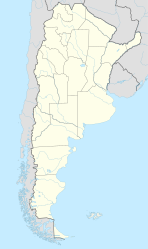Santiago del Estero
| Santiago del Estero | ||
|---|---|---|
| City | ||

(From top to bottom; from left to right) Aerial view of the city; Santiago del Estero Cathedral; Plaza Libertad; Santiago del Estero Cultural Complex and Monument to Belgrano
|
||
|
||
| Nickname(s): Mother of Cities | ||
| Location of Santiago del Estero in Argentina | ||
| Coordinates: 27°47′S 64°16′W / 27.783°S 64.267°WCoordinates: 27°47′S 64°16′W / 27.783°S 64.267°W | ||
| Country | Argentina | |
| Province | Santiago del Estero | |
| Department | Capital | |
| Government | ||
| • Mayor | Hugo Orlando Infante (Frente Cívico) | |
| Area | ||
| • Total | 2,116 km2 (817 sq mi) | |
| Elevation | 182 m (597 ft) | |
| Population (2001 census [INDEC]) | ||
| • Total | 244,733 | |
| • Density | 120/km2 (300/sq mi) | |
| Demonym(s) | santiagueño | |
| Time zone | ART (UTC−3) | |
| CPA base | G4200 | |
| Dialing code | +54 385 | |
Santiago del Estero (Spanish pronunciation: [sanˈtjaɣo ðel esteɾo], Spanish for Saint-James-Upon-The-Lagoon) is the capital of Santiago del Estero Province in northern Argentina. It has a population of 244,733 inhabitants, (2001 census [INDEC]) making it the twelfth largest city in the country, with a surface area of 2,116 km². It lies on the Dulce River and on National Route 9, at a distance of 1,042 km north-northwest from Buenos Aires. Estimated to be 455 years old, Santiago del Estero was the first city founded by Spanish settlers in the territory that is now Argentina. As such, it is nicknamed "Madre de Ciudades" (Mother of Cities). Similarly, it has been officially declared the "mother of cities and cradle of folklore."
The city houses the National University of Santiago del Estero, founded in 1973, and the Universidad Católica, founded in 1960. Other points of interest include the city's Cathedral, the Santo Domingo Convent, and the Provincial Archeology Museum.
The Santiago del Estero Airport is located 6 kilometres north of the city, and has regular flights to Buenos Aires and San Miguel de Tucumán.
The climate is subtropical with a dry season, usually winter and sometimes autumn. It receives an average annual precipitation of 600 mm, and the climate is warm and dry.
Santiago del Estero and its region are home to about 100,000 speakers of the local variety of Quechua, making it the southernmost outpost of the language of the Incas. It is one of the few indigenous languages surviving in modern Argentina.
...
Wikipedia


